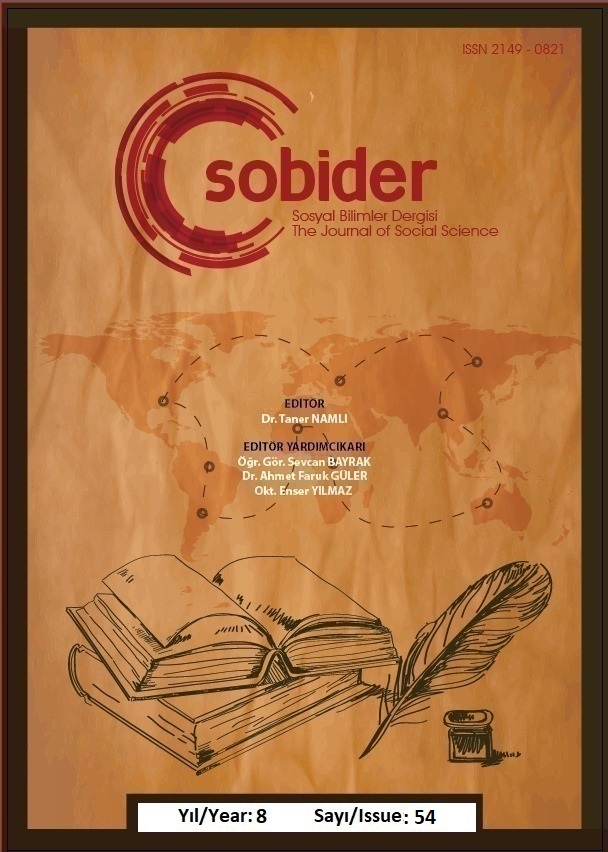YAPAY ZEKÂ DESTEKLİ İÇ MİMARİ TASARIM VE SUNUM ARAÇLARINDA BULUT TABANLI BİR YAZILIM: COOHOM ÖRNEK OLAY İNCELEMESİ
Author :
Abstract
İç mimarlık; tasarım, sunum, üretim ve uygulama süreç basamaklarını içeren çok yönlü bir disiplindir. Mesleki süreçte birçok araçtan faydalanılmaktadır. Böylece etkin bir biçimde nihai sonuca ulaşılmaktadır. Teknoloji etkisiyle iç mimarlık araçları zaman içerisinde değişim ve çeşitlilik göstermiştir. Günümüzde devam eden geleneksel sistemde tasarım-sunum süreci elle çizim aletleri kullanılarak yürütülürken teknolojinin ilerlemesiyle birlikte günümüz uygulamalarına bilgisayar desteği gelmiştir. Son yıllarda geliştirilen birçok yazılım, bilgisayarlar ve tabletler aracılığıyla iç mimarlığın tasarım-sunum sürecine olanaklar sunmaktadır. Tasarımın panoramik deneyimlenebilmesine olanak veren 360° görüntü, sanal gerçeklik gözlükleriyle gezilebilen mekânlar ve gerçekle program çıktısının ayırt edilemeyeceği realitede mekân görselleri oluşturabilme bu olanaklar içerisindedir. Kullanılan yazılımların algoritmik yapıları gereği aslında disiplin içerisinde uzun süredir faydalanılan yapay zekânın rolü günümüzde çok daha fazladır. Çalışmada yapay zekâ destekli, bulut tabanlı bir tasarım ve sunum aracı olan Coohom yazılımının örnek olay üzerinden deneyimlenmesi hedeflenmektedir. Elde edilecek verilerle yapay zekânın günümüzde iç mimarlığa sunduğu olanakların analizi sunulacaktır.
Keywords
Abstract
Interior architecture is a versatile discipline that includes design, presentation, production, and implementation processes. Many tools are used in the profession’s processes. Thus, the ultimate result is reached effectively. Due to the impact of technology, interior architecture tools have changed and diversified over time. While the design and presentation process in the traditional system that is ongoing nowadays is carried out using free-hand drawing tools, computer support has come to today's applications along with the developing technology. Many software developed in recent years is offered possibilities for the design and presentation process of interior architecture via computers and tablets. 360° view that allows the panoramic experience of the design, the spaces that can be experienced with VR glasses and the creation of space visuals in a reality which the reality and the program output cannot be distinguished is among these possibilities. Actually, on account of the algorithmic structures of the software used, the role of AI, which has been utilized in the profession for a long time is much more nowadays. The study aims to experience Coohom software which is AI-powered, cloud computing-based design and presentation tool, through the case study. Due to the data to be obtained, it will be possible to analyze the possibilities that AI offers to interior architecture today.
Keywords
- Baudrillard Jean, Simülakrlar ve Simülasyon, çev. Oğuz Adanır. 6. Baskı, Ankara: Doğu Batı Yayınları, 2011.
- Bernstein Phillip, “AI in Architecture”, Konsept Projeler, S. 61, 2019, ss. 68-71.
- Bingöl Orhan, Arkeolojik Mimaride Taş, 1. Baskı, İstanbul: Homer Kitabevi, 2004.
- Cevizoğlu Hulki, “Yapay Zekâ, Teknoloji Felsefesi ve Toplumsal Yaşam”, Yapay Zekâ ve Gelecek, ed. Gonca Telli, 1. Baskı, İstanbul: Doğu Kitabevi, 2019, ss. 88-109.
- Demirarslan Deniz, Oğuz Demirarslan, Tasarım ve Tasarım Süreci, Ankara: İksad Yayınevi, 2020.
- Demirarslan Sibel, “Mimari Proje Tasarım Süreci için Bir Çalışma Modeli”, ed. Pulatov Xayrulla Lutpullaevich, Euro Asia 8th. International Congress on Applied Sciences, 2021, pp. 818-830.
- Dodsworth Simon, Stephen Anderson, İç Mekân Tasarımının Temelleri, çev. Neslihan Şık. 2. Baskı, İstanbul: Literatür Yayınları, 2015.
- Esin Emin Murat, “Yapay Zekânın Sosyal ve Teknik Temelleri”, Yapay Zekâ ve Gelecek, ed. Gonca Telli, 1. Baskı, İstanbul: Doğu Kitabevi, 2019, ss. 110-138.
- Frey Carl Benedikt, Michael A. Osborne, “The Future of Employment: How Susceptible are Jobs to Computerisation?”, Technological Forecasting and Social Change, C. 114, 2017, ss. 254-280.
- Gönenç Sorguç Arzu, Semra Arslan Selçuk, “Yapay Zekâ Araştırmaları ve Biomimesis Kavramlarının Günümüzde Mimarlık Alanındaki Uygulamaları: Akıllı Mekânlar”, Yapı ve Kentte Bilişim IV. Kongresi, Ankara, 2006, ss. 75-80.
- Görgül Ercüment, “Yapay Zekâ ve Dokunulabilir Ortam Bağlamında Mimarlıkta Bilgisayar Destekli Temsiliyet ve Uygulamaları”, Arredamento Mimarlık, S. 6, 2001, ss. 89-93.
- Kolatan Şulan, “Bilişim Ağı / Khimaira Paradigması”, Mimarlık ve Sanallık, ed. Nuray Togay, 1. Baskı, İstanbul: Boyut Yayın Grubu, 2002, ss. 31-36.
- Kuban Doğan, Mimarlık Kavramları: Tarihsel Perspektif İçinde Mimarlığın Kuramsal Sözlüğüne Giriş. 6. Baskı, İstanbul: Yem Yayın, 2002.
- Luthra Natasha, “AI in Architecture”, Konsept Projeler, S. 63, 2019, ss. 90-93.
- Özgel Felek Seval, “İç Mekân Tasarımında Görselleştirme Yöntemleri ‘Lupa Cr29 Projesi Üzerinden Örneklenmesi’”, IDA: International Design and Art Journal, C. 1, S. 1, 2019, ss. 13-30.
- Özgenel Fırat, Arzu Gönenç Sorguç, “Sayısal Ortamda, Tasarımın Deneyimlenmesi İçin Arayüzlerin Geliştirilmesi: Bir Ön-Tasarım Parametresi Olarak Ses”, METU JFA, C. 28, S. 2, 2011, ss. 243-253.
- Öztürk Ekin, “Mimarlığın Geleceği: Ütopya mı, Distopya mı?”, Yapı Dergisi, S. 436, 2018, ss. 42-44.
- Simon Herbert, “Mimarlık ve Yapay Zekâ-Bilim Üzerine”, Arredamento Mimarlık, S. 6, 2001, ss. 77-81.
- Wodzicki Christopher, “AI in Architecture”, Konsept Projeler, S. 62, 2019, ss. 76-79.
- Yıldız Pelin, İç Mimarlıkta “Yapay Zekâ” ve Türkiye’den Seçilmiş Örneklerin Mekân Tasarımı Yönünden Kapsamlı Analizi Çalışması. 1. Baskı, Ankara: Hacettepe Üniversitesi Yayınları, 2014.
- Yılmaz Atınç, Yapay Zekâ. 6. Baskı, İstanbul: Kodlab, 2019.
- https://uiaa.org/2020/02/18/the-home-team/ erişim: 04/05/2021.
- https://smartdecordesign.com/articles/mobile-devices-and-cloud-computing-are-revolutionizing- interior-design/ erişim: 04/05/2021.
- https://www.forbes.com/sites/bensin/2018/04/03/how-three-chinese-entrepreneurs-built-a- software-that-helps-citizens-build-homes-from-the-ground-up/?sh=1137931f1b5f erişim: 04/05/2021.
- https://help.coohom.com/what-is-kooai-design erişim: 12/04/2021.
- https://www.techinasia.com/cloud-design-service-speeds-3d-models-china erişim: 04/05/2021.
- https://help.coohom.com/how-to-search-floor- plan?kpm=DjrK.9e7257a25684cc0c.b801547.1618166912508 erişim:11/04/2021.
- Görsel 2: https://help.coohom.com/panorama-settings erişim: 20/04/2021.
- Görsel 3: https://qhstaticssl.coohom.com/newt/886/application/pdf/1586341044280/D63E4892E0 3B32FDCF3EABBFA4A6CFCC.pdf erişim: 20/04/2021.
- Görsel 4,5: https://help.coohom.com/panorama-settings erişim: 20/04/2021.
- Görsel 6: https://www.coohom.com/pub/tool/yundesign/cloud?redirecturl=/pub/saas/apps/project/ list&redirectbim=false&kpm=qkWL.b63a5ddeb104964f.558636e.1630768749941&loc ale=en_US erişim: 04/09/2021.
- Görsel 7,8,9,10,11,12,13: https://www.coohom.com/pub/tool/yundesign/cloud?designid=3FO4963J7MK8&redire cturl=/pub/saas/apps/project/list&redirectbim=false&kpm=qkWL.b63a5ddeb104964f.5 58636e.1630768874401&locale=en_US erişim: 04/09/2021.
